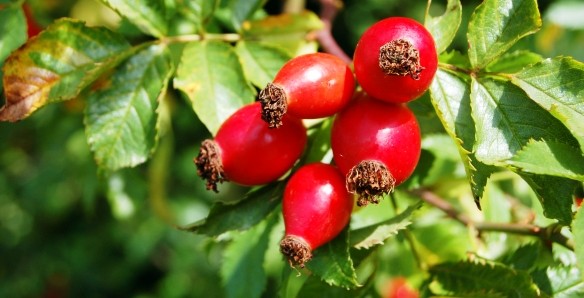Chinese herb, hawthorn berry – also known as Shan Zha – has been considered one of the best medicines for strengthening the Spleen, regulating appetite, promoting digestion, relieving food retention, and activating blood to break up the stasis. It’s characteristic properties of softening hard mass and removing food retention were found unintentionally by our forefather when they cooked old chicken meat and hard meat with a few hawthorn berries and found that the meats were more easily to turn soft. Documented use of hawthorn, dates way back to 659AD, and in Europe, the use of hawthorn can be traced back to the time of Dioscorides and Paracelsus. It has been suggested they praised hawthorn for its heart-strengthening properties.
What is hawthorn berry good for you may ask!
Combination of hawthorn berry with other herbs can be a good remedy for indigestion, anorexia in children, infant diarrhea, dysentery, abdominal pain, postpartum blood stasis, and more.
a) 89 cases of hyperlipidemia in middle-aged and elderly adult have been treated with hawthorn-based Jiang Zhi Le (literally Lipid-lowering Happy). The results showed that the efficiency of lowering cholesterol and triglycerides were 69.49% and 80.28% respectively. What’s more, it can still improve a poor appetite, lassitude, lack of energy, high blood pressure, and other symptoms.
b) 186 cases of angina pectoris have been treated with Xin Xu Ning Pin, which is made from the extract of hawthorn and Ge Gen (Kudzu Root). And the efficiency is 89.87%. In addition, it has a very good blood pressure and lipid-lowering efficacy too.
c) 105 cases of acute and chronic pyelonephritis have been treated with decoction of 90g hawthorn on daily basis (treatment of children with reduced-dose). And the remedy was with a good result.
Besides, it is also widely used in the treatment of hepatitis, delayed menstruation, lower limb soft tissue injuries, intractable hiccups, vocal cord polyps, frostbite, and so on.
In Western herbal medicine, hawthorn is the principle herb used to promote vascular health. According to Mills & Bone (2013) hawthorn is summarised as a mild cardiotonic, cardioprotective, antioxidant, collagen stabilising, mild astringent, mild hypotensive.
Hawthorn contains a high amount of oligomeric procyanidins (OPCs) and flavonoids that play a role in its therapeutic effects.
OPC’s are a type of tannin which contain catechins and or epicatichins. They are high in antioxidants and have an astringent effect in the body. Astringents have the ability to precipitate proteins, which provide a protective barrier in exposed tissues or mucus membranes.
Vitexin and isovitexin are flavonoids present in hawthorn. It has been suggested that these components show a range of pharmacological activity including antioxidant, anti-inflammatory and anti-hypertensive in healthy individuals.
* Always consult with your physician prior to consuming hawthorn. If symptoms persist seek medical advice.
TCM – Herb Actions
Reduces Food Stagnation, Transforms Accumulation
Especially effective for improved digestion of red meat and oily, greasy and fatty foods. Treats indigestion with abdominal distention, pain and or diarrhea
- Disperses Blood Stagnation, Dissipates Clumps
Treats post-partum or amenorrhea abdominal pain and spotting. Used for hernia and bulging disorders. - Treats Cardiovascular Disease
Treats hypertension, coronary artery disorder, angina, high cholesterol - Stops Diarrhea
Treats chronic dysentery disorders
Chinese Herb Contraindications & Cautions
- Do not use during pregnancy
- Use with caution in cases with Spleen and Stomach Deficiency
- Use with caution in cases with gastritis or peptic ulcers
- Do not take long term, it can harm the flow of Spleen and Stomach Qi
Reference List
Braun, L, Cohen, M 2015, Ed 4, Herbs & Natural Supplements an Evidence Based Guide, Churchill Livingstone, China
Chang, Q, Zuo, Z, Harrison, Chow, MSS 2002, ‘Hawthorn’, Journal of Clinical Pharmacology, Vol. 42, Pp. 605-612, Viewed 8 march 2018, <http://ebscohost.com>
He, M, Min, JW, Kong, WL, He, XH, Li, JX, Peng, BW 2016, ‘A review on the pharmacological effects of vitexin and isovitexin’, Filoterapia, Vol. 115, Pp. 74-85, Viewed 8 March 2018, http://www.sciencedirect-com
Pengelly, A 2004, Ed2, The Constituents of Medicinal Plants, CABI, UKReference
He Nan Zhong Yi (Henan Chinese Medicine), 1990;4:23;
Zhong Cheng Yao (Chinese Patent Medicine), 1994;7:25;
Shan Xi Xin Yi Yao (Shaanxi New Medical Journal), 1975;1:35.
Zhong Guo Shi Pin Bao (China Food Industry News), 2001;02.01.


